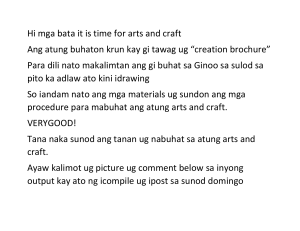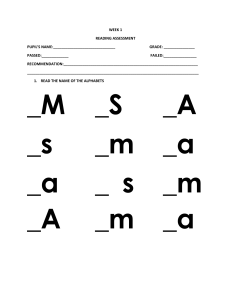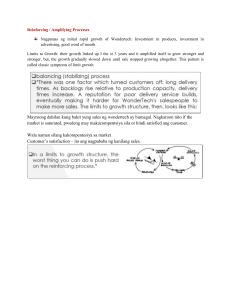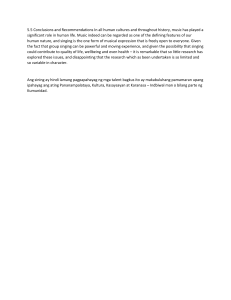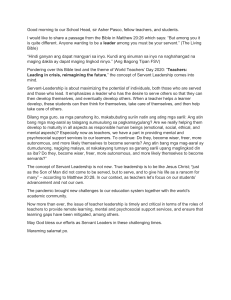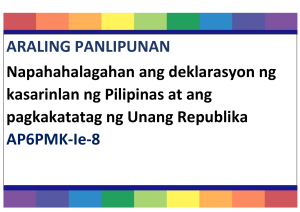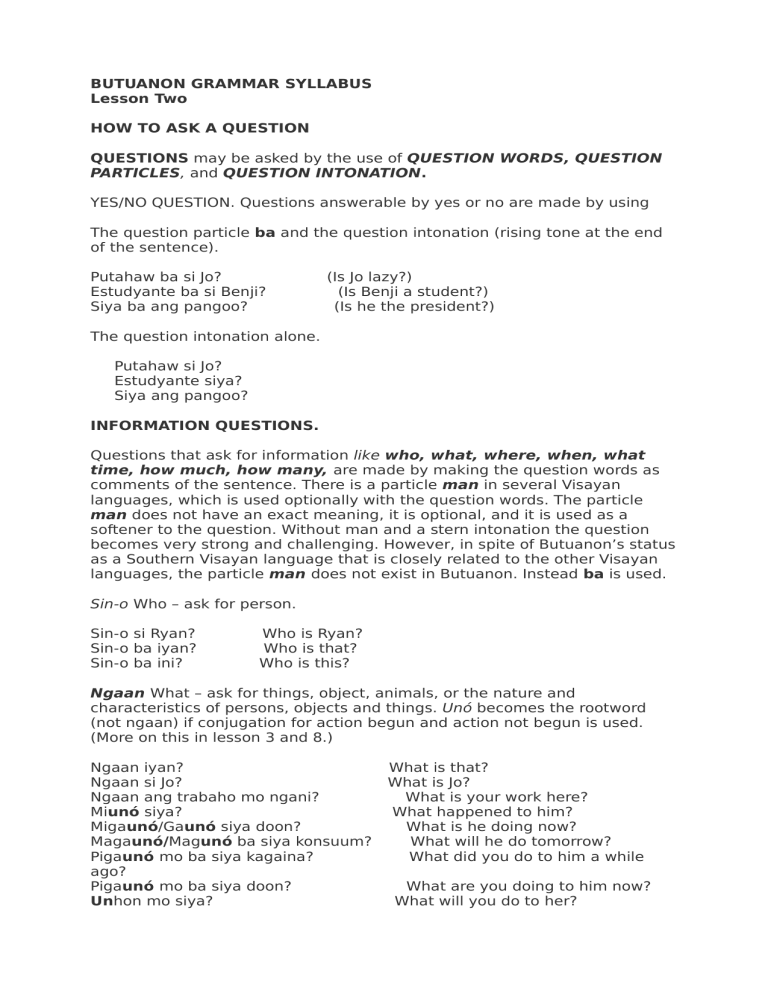
BUTUANON GRAMMAR SYLLABUS Lesson Two HOW TO ASK A QUESTION QUESTIONS may be asked by the use of QUESTION WORDS, QUESTION PARTICLES, and QUESTION INTONATION. YES/NO QUESTION. Questions answerable by yes or no are made by using The question particle ba and the question intonation (rising tone at the end of the sentence). Putahaw ba si Jo? Estudyante ba si Benji? Siya ba ang pangoo? (Is Jo lazy?) (Is Benji a student?) (Is he the president?) The question intonation alone. Putahaw si Jo? Estudyante siya? Siya ang pangoo? INFORMATION QUESTIONS. Questions that ask for information like who, what, where, when, what time, how much, how many, are made by making the question words as comments of the sentence. There is a particle man in several Visayan languages, which is used optionally with the question words. The particle man does not have an exact meaning, it is optional, and it is used as a softener to the question. Without man and a stern intonation the question becomes very strong and challenging. However, in spite of Butuanon’s status as a Southern Visayan language that is closely related to the other Visayan languages, the particle man does not exist in Butuanon. Instead ba is used. Sin-o Who – ask for person. Sin-o si Ryan? Sin-o ba iyan? Sin-o ba ini? Who is Ryan? Who is that? Who is this? Ngaan What – ask for things, object, animals, or the nature and characteristics of persons, objects and things. Unó becomes the rootword (not ngaan) if conjugation for action begun and action not begun is used. (More on this in lesson 3 and 8.) Ngaan iyan? Ngaan si Jo? Ngaan ang trabaho mo ngani? Miunó siya? Migaunó/Gaunó siya doon? Magaunó/Magunó ba siya konsuum? Pigaunó mo ba siya kagaina? ago? Pigaunó mo ba siya doon? Unhon mo siya? What is that? What is Jo? What is your work here? What happened to him? What is he doing now? What will he do tomorrow? What did you do to him a while What are you doing to him now? What will you do to her? Kun-o: When (future, time in general) Gan-o: When (past) Kun-o ang parti? Gan-o ra ba ang kaadlawan mo? Kun-o ang pista ngani? Gan-o ba siya mikaon? Kun-o siya mukaon? When is the party? When was your birthday? When is the fiesta here? When did she eat? When will he eat? Ngaan orasa What time (oras – hour ) What hour – ask for particular time, ADLAWA – day, BUWANA – month, TUIGA – year and other such words can take the place of orasa, depending on the particular question. Ngaan orasa ang parti? What hour is the party? Ngaan adlawa ang miting? What day is the meeting? Ngaan tuiga ang World War II? What year was the World War II? Ngaan buwana ang kaadlawan mo? What month is your birthday? Ngaan orasa siya mukaon kada hinaat? When/What time does he eat every morning? Diin(Past) ,Kain (present and future): Where Taga-diin ikaw? What place did you come from? Diin ba siya gahapon? Where was he yesterday? Kain ba siya doon? Where is she now? Kain ba siya konsuum? Where is she tomorrow? Pakain ba siya konsuum? Where is she going tomorrow? Kain ba ang kasilyas? Where is the comfort room? Man-o: How much? (What is the price?) Gan-o: How many? Man-o ba iyan? Man-o ba ang abang kada buwan? Man-o ba ang suweldo niya? Gan-o ka buok? Gan-o ba kataud ang mga anak mo? Gan-o ba kamo kataud? Gan-o ba kataud ang mga estudyante? Gan-o kataud ang mga tapok? Man-o ang kada tapok? Man-o ang isa ka buok? Man-o ang isa ka ligid? How much is that (right there?) How much is the rent a month? How much is his salary? How many pieces? How many are your children? How many of there are you? How many students? How many piles are there? How much is each pile? How much is one piece? How much is each tire? ANSWERS TO : Yes /No Questions. These questions are answered by a shake of the head or by: Yes – OO/HUO or by HU-O plus the repetition of the sentence. Estudyante ba si Pedro? Oo/Huo Si Tony ba ang maestro? Hu-o, siya ang maestro. No – DII plus a sentence for most non-verbal sentence. WAA plus a sentence for sentence beginning with yaoy, yaon, yani, yaton, disaon, yadto, etc. Tubag/answer Yaoy radyo mo? (Do you have a radio?) holding.) Way panaw mo doon? (Do you have a trip now?) Yaton si Boyet baay nyo? (Is Boyet there in your house?) Kain ba si Crys? (Where is Cris?) Huo, hani ra, ining pigakaptan ko. (Yes, it’s just here, this thing I’m Yaon. (I have.) Huo, yani suod. (Yes, he is here inside.) Yadto Camuigin, gabakasyon. (There in Camiguin, on vacation.) Information Question. These questions may be answered by stating directly the answers or whatever is asked for with or without repeating the sentences. Tubag/answer Sin-o ba ang amigo mo? Ngaan iyan? Kun-o ba ang parti? Ngaan orasa ang parti nato? Kain ba si Tiron? Man-o ba iyan? Man-o ba ang tapok hong kamote? Gan-o kataud ang mga anak mo? Si Jo ang amigo ko. Libro iyan. Konsuum (tomorrow) ang parti. Ngaun (Later at) alas otso ang parti. Yadto Villa Kanagga si Tiron. Singko pesos iyan. Tagdiyes pesos ang tapok. Unom ka buok ang mga anak ko. Aims for the lesson 1. Learn how to use ba question particles. (Butuanon has no particle ‘man’. Instead ‘ba’ is used in Butuanon.) 2. Learn to ask sin-o and ngaan information questions correctly. 3. Learn how to answer Butuanon questions properly. 4. More practice of descriptive, classification, and equational type of sentences. Tape Pattern Drills Response Drill Answer the following questions with words or cues given. Say out loud your answers, then listen to the answers provided by the tape and then repeat the answers as given by the tape. The English equivalents of the cues are given on the right side of the page. Tubag (answer) Sin-o ba si Lino? Ang maestro. Sin-o ba si Bobi? ang estudyante. Sin-o ba si Bobit? ang kura paroko. Sin-o ba si Sister Junalyn? ang prinsipal. Sin-o ba si Cris? ang OIC. Sin-o ba si Kora? Sya ang maestro. (He is the teacher.) Estudyante sya. (He is a student.) Sya ang kura paroko. (He is the parish priest.) Sya ang prinsipal. (She is the principal.) Sya ang OIC. (She is the OIC.) Libraryan sya. ang libraryan. Sin-o ba si Manoy Roly? ang Superyor. Sin-o ba sinda Bobit? ang mga masusuwat. Sin-o ba sinda Bobi? ang mga estudyante. Sin-o ba ang diriktor? Si Roly . Sin-o ba ang superbisor? Si Timi . Sin-o ba ang OIC? Si Bibi . Sin-o ba ang libraryan? Si Lina . Sin-o ba ang mga estudyante? Sinda Bobi . students.) Sin-o ba ang mga maestro? Sinda Lino . teachers.) Sin-o ba ang mga dyanitor? Sinda Benji . Ngaan ba si Bobi? Esyudyante . Ngaan ba si Marlon? Magtutudlo . Ngaan ba si Lina? Magtutudlo . Ngaan ba sinda Bobi? Mga estudyante . students.) Ngaan ba sinda Bibi? Mga magtutudlo . teacher.) Ngaan ba sinda Kora? Mga magtutudlo . Ngaan ba ang libro? Mahal . Ngaan ba ang ngadto suud sinehan? Mahagkut . Maestra ba si Cory? Huo. Estudyante ba si Bobi? Huo (She is the librarian.) Sya ang Superyor (He is the Superior.) Mga manunulat sila. (They are writers.) Mga estudyante sila. (They are the students.) Si Roly ang diriktor. (Roly is the director.) Si Timi ang superbisor. (Timi is the supervisor.) Si Bibi ang OIC. (Bibi is the OIC.) Si Lina ang librarian. (Lina is the librarian) Sinda Bobi ang mga estudyante. (Bobi and his companions are the Sinda Lino ang mga maestro. (Lino and the others are the Sinda Benji ang mga dyanitor. (Benji and his allies are the janitor.) Estudyante si Bobi. (Bobi is a student.) Magtutudlo si Marlon. (Marlon is a teacher.) Magtutudlo si Lina. (Lina is a teacher.) Mga estudyante sinda Bobi. (Bobi and his friends are the Mga magtutudlo sinda Bibi. (Bibi and her friends are the Mga magtutudlo sinda Kora. (Kora and her friends are teachers.) Mahal ang libro. (The book is expensive.) Mahagkut ngadto suud sinehan. (the laboratory is too cold.) Huo, maestra si Cory. (Yes, Cory is a teacher.) Huo, estudyante si Bobi. (Yes, Bobi is a student.) Lesson Two Estudyante ba si Helen? Dii estudyante si Helen. Dii,__. Magtutudlo ba si Bobi? Dii magtutudlo ba si Bobi. Dii, . Mga estudyante ba sinda Bibi? Huo, mga estudyante sinda Bibi. Huo, . Mga magtutudlo sinda Kora? Huo, mga magtutudlo sinda Kora. Huo, . Mga estudyante ba sinda Hudet? Dii. Dii sila mga estudyante. Dii, . Mga magtutudlo ba sinda Bobi? Dii. Dii sila mga magtutudlo. Dii, . Mga pari ba sinda Bobit? Huo, mga pari sila. Huo, . Mahal ba ang libro? Huo, mahal ang libro. Huo, . Mahagkut (cold) ba ngadto suud sinehan? Huo, mahagkut ang ngadto suud. Huo, . Si Lina ba ang libraryan? Huo, si Lina ang libraryan. Huo, . Si Hudet ba ang OIC? Huo, si Hudet ang OIC. Huo, . Si Timi ba ang diriktor? Huo, siya ang diriktor. Huo, . Si Denis ba ang bag-o nga estudyante? Huo, . Huo, siya ang bag-o nga estudyante. QUESTION DRILL Ask questions either with sin-o ba, ngaan ba, or ba to the answers, which are the sentences given. Use the cues given to form your questions. Say out loud your questions, listen to and then repeat after the questions provided by the tape. Tubag/Answer Si Lino ang maestro hong grammar. Sin-o ba ang maestro hong grammar? Si Kora ang superbisor. Sin-o ba ang superbisor? Si Bobit ang kura paroko. Sin-o ba ang kura paroko? Si Timi ang superyor. Sin-o ba ang superyor? Sinda Jo ang mga SOLFED. Sin-o ba ang mga SOLFED? Sinda Boyet ang mga magtutudlo. Sin-o ba ang mga magtutudlo? Si Lina ang libraryan. Sin-o ba ang libraryan? Estudyante si Bobi. Ngaan ba si Bobi? Pari si Denis. Ngaan ba si Denis? Magtutudlo si Kora. Ngaan ba si Kora? Mga Amerikano sinda Bobi. Ngaan ba sinda Bobi? Mga Pilipino sinda Bobiros. Ngaan ba sinda Bobiros? Mahal ang libro. Ngaan ba ang libro? Mahagkut(cold) ang lab. Ngaan ba ang lab? Mapaso (hot) ang kape. Ngaan ba ang kape? Kugihan si Joy. Ngaan ba si Joy? Tambok ang bata. Ngaan ba ang bata? Niwang ang tawo. Ngaan ba ang tawo? Estudyante si Bobi. Ngaan ba si Bobi? Magtutudlo si Lina. Ngaan ba si Lina? Si Joy ang officer-in-charge. Ngaan ba si Joy? Si Lina ang libraryan. Ngaan ba si Lina? Si Timi ang Superyor. Ngaan ba si Timi? Lesson Two Sinda Bibi ang mga bag-ong estudyante. Ngaan ba sinda Bibi? Mga Amerikano sinda Bobi. Mga Pilipino sinda Jo. Broadcaster sinda Ryan, Sol, Boyet. Butuanon si Marisol. Si Benji DJ. Siya ang diriktor hong salida nga Bisaya. Ngaan ba sinda Bobi? Ngaan ba sinda Jo? Ngaan ba sinda Ryan? Ngaan ba si Marisol? Ngaan ba si Benji? Ngaan ba siya? Express the following sentences in Butuanon. 1.Is Jade a student? 2.Is he a Filipino? 3.Who is the mayor of Butuan? 4.Who is the President of the Philippines? Boyet? 5.What is your work? Ador? 6.Who is your friend? 7.Who is the new student? 8.Where is the office of Bobit? 9. Is the school big? 10. Is Lalang the librarian? 11. Is Logo a teacher? 12. Are you the father of 13. Is Logo the son of Manoy 14. What is this? 15. Is that your book? Tubag/ Answer 1. Si Jade ba estudyante? 2. Siya ba Filipino? 3. Sin-o ba ang mayor hong Butuan City? 4. Sin-o ba ang Pangoo hong Pilipinas? 5. Ngan bay trabaho mo? 6. Sin-o bay mga amigo mo? 7. Sin-o ba ang bag-o nga estudyante? 8. Kain ba ang opisina ni Bobit? 9. Ang andanan ba madakwa/ 10. Si Lalang ba Libraryan? 11. Si Logo ba ang maestro? 12. Ikaw ba ang ama ni Boyet? 13. Si Logo ba ang buntanak ni Manoy Ador? 14. Ngan ba ini? 15. Imo ba iyan libro? For each sentence, do the following: Identify sentence as to its type. Ask the appropriate question information for each. Sekretarya si Marisol hong dakwa nga opisina. Buotan katsaong asidô siya. Daagah pa siya. Si Manoy Miyo ang ama niya.Waa nay ina niya. Maas na si Manoy Miyo. Si Bantay ang idò (dog) ni Marisol. Si Miming sab ang apík (cat) niya. Tambok si Bantay pero gaan. Hong laktud pa, niwang si Miming pero bug-at. What possible information questions are ask at: A A A A bus terminal school restaurant market 1) I would like to accompany him to Talakugon tomorrow. 1) Gusto ko kunta ibanan siya ngadto Talakugon kunsum. 2) But it’s really unlucky because my father will arrive. 2) Pero dimalas gid kay moabut ang ama ko. 3) He will come because he will buy tools for the farm. 3) Mokani siya kay mobili siya hong mga gamitonon para hong basakan. 4) He will also get the title of our land. 4) Kaw-on sab niya ang titulo hong lupa namo. 5) He will go home on Tuesday afternoon. 5) Mo-uli siya doon Martes hong hapon. 6) Manoy Ador will stop by for him. 6) Hapitan siya ni Manoy Ador. 7) Manoy Ador has a jeepney and then they will go together in returning home. 7) Si Manoy Ador yaoy dyip kaamo mag-iban na sila pag-uli. Lesson Two 1) Felix and Tiron are friends. 1.) Mag amigo sinda Felix katsaong Tiron. 2) Felix is from Bancasi and he is a son of Manoy Ador. 2) Taga Bancasi si Felix kaamo anak siya ni Manoy Ador. 3) Manoy Ador is the owner of an eatery. 3) Si Manoy Ador tag-iya hong karinderia. 4) Boyet is also from Bancasi and his father is a farmer. 4) Si Boyet sab, taga- Bancasi kaamo magabasakay ang ama niya. 5) Boyet is not brainy, but he is kind. 5) Dii utokan kadyaw si Boyet, pero buotan siya. 6) Tiron is brainy but he is poor. 6) Si Tiron madiyaw ang utok pero pobre. 7) Even so (lit.even with that) they are still close friends. 7) Bisan pa laong saon/haon, suod gihapon sila nga amigo. Mga Pangasubò Tubag Sin-o ba ang mag-amigo? Taga-kain ba iyan si Boyet? Sin-o ba ang anak ni Manoy Ador? Sin-o ba iyang si Manoy Ador? Sin-o ba ang tag-iya siya hong karinderia? Taga-kain ba sab iyan si Felix? Ngaan bay trabaho hong ama ni Boyet? Si Felix katsaong Tiron. Bancasi. Felix. Tag-iya siya hong karinderia. Manoy Ador. Bancasi. Magabasakay. Translation exercise. Translate the English essay into Butuanon: Butuanon is one of the Visayan languages. Specifically it belongs to the Southern branch of Visayan. As such, most of the words in its vocabulary are cognate to the words found in other Visayan languages. Its grammatical rules are also similar to its fellow Visayan languages Surigaonon and Cebuano. Isa ka Binisaya nga lin-guahe ang Binutuanon. Mabutang ini ngadto Lawood nga sanga hong mga Binisaya nga mga lin-guahe. Kaamo, kasagaran hong mga pulong sani makit-an sab ngadto iban nga mga Binisaya nga mga lin-guahe. Ang grammar niya kaanggid sab hong Surigaonon, Cebuano, katsaong iban nga mga Binisaya nga mga linitukan. There is a common misconception that Butuanon is a dialect, but in fact it is a language. Dialects are defined by international linguistic standards as mutually intelligible versions of a language. For example, the common medium of communication in Baranggay Babag Butuan City is mutually intelligible with the one used in Talakugon Municipality; thus both are dialects of the same language, which is called Butuanon by international linguists. Butuanon as a language is at par with the other 160 or so Philippine languages, including Tagalog, and the rest of the world’s languages. To call Butuanon a dialect does not do justice to this rich and complex language. Yaoy sayop nga paghuna-huna nga isa ka dayalek and Binutuanon, nga kun tinuod isa ini ka lin-guahe. Laong hong mga lin-guis hong kalibutan, ang mga dayalek amo ang mga kinalain-lain nga klase hong isa ka lin-guahe nga magkasinabot. Kaw-on nato ang linitukan ngadto Baranggay Babag katsaong Talakugon. Magkasinabot sila nga mga linitokan. Kaamo, kabahin ini nga mga dayalek hong isa ka lin-guahe, ang pigatawag hong mga linguis nga Binutuanon. Ang Binutuanon katupong hong mga iban nga mga lin-guahe hong Pilipinas (nga mga 160 kataud), lakip na ang Tagalog, katsaong mga iban nga mga linguahe hong kalibutan. Dii gid tarong nga tawgon lang ‘dayalek’ ang Binutuanon. End of Lesson Two

